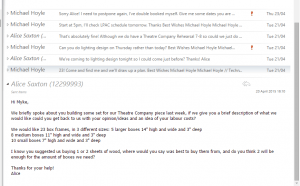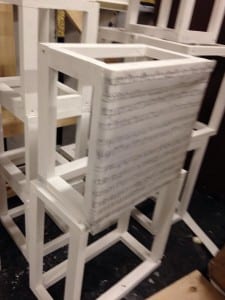As of January when our process began, I have been creating a company schedule. ‘A well organized rehearsal schedule is the key to dealing effectively with the stage management workload’ (Bond, 1991, 49) and allows both the creative and production sides of the company to remain on track. As of this week I have found the most effective way to create this schedule, is to dedicate 15minutes to the beginning of the rehearsal week to find out cast availability; although ideally the company would be free to partake in any rehearsals or meetings required of them, the circumstances in which we are creating this piece really hinders availability.
As seen by this schedule, we have been work-shopping for a few weeks now and more defined style and concept is beginning to emerge! Having discovered the illness Encephalitis, a form of the herpes simplex that transfers to the brain and causes severe memory loss, our piece has started to focus on the effects memory loss has upon relationships. In terms of production, some very distinctive ideas have surfaced. A couple of the company recently attended a show at Lincoln Drill Hall called Stateless (2014). The piece was inherently dance theatre, and thus the set had to be adaptable in order to allow the space the performers required – as, so far, our piece ia appearing very physical, this was an important idea for us to consider in these early stages. They used large, misshapen blocks that progressively came together to create one larger block. For myself and our company designer, this really inspired some concept ideas for set. In our most recent production meeting, we discussed having numerous blocks or boxes that come together to create an image. The boxes would incorporate photos, letters and objects that represented the memories of our characters. ‘The distinction between props and scenery gets muddy at times, and clear assignments should always be made’ (Campbell, 2004, 4), especially when all the aspects of your set can be handled and moved by the cast. In order to avoid this confusion, we have agreed that our designer will focus more-so on sourcing all props – ‘anything that is carried by the actor’ (Campbell, 2004, 4) – whilst I will begin to source the materials etc. for our set.
So far all of our technical ideas are quite sciencey in style, and I am extremely excited to see how this concept develops!
Works Cited
Bond, D. (1991) The Stage Management: A Gentle Art. New York: Routledge.
Cambell, D. (2004) Technical Theatre: For Nontechnical People. New York: Allworth Press
Joli Vyann. (2014) Stateless. [performance] Lincoln Drill Hall, 19th February 2015.

